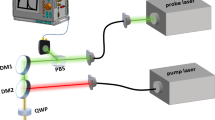Abstract
Normally, for Standard DSC, the PerkinElmer power-compensation setting is the low dynamic range mode (LDRM). In this mode, a noise filter is applied to decrease the noise-to-signal ratio, which concomitantly gives rise to a delay in time of the signal measured. In case the signal is expected to be of high intensity — experienced for instance at high scan rates using High Performance DSC (HPer DSC) — the noise filtering could be diminished by which the associated delay in time would be less, leading to a faster response of the instrument, also resulting in an improved resolution. In fact, such can be realized using the faster noise filter of the high dynamic range mode (HDRM) available for the Pyris 1 and Diamond DSCs, which DSCs are both equipped with the HyperDSCTM technique (HyperDSC being the commercial version of HPer DSC). The improvement in response is maximal for high rates like 100–500°C min−1 but even at low rates like 10°C min−1 it is still significant. Thus, taking advantage of HDRM, low-molar substances like indium and 4,4′-azoxyanisole show appreciable increasing height-to-width ratios for signals caused by crystallization, melting and the crystal <>liquid crystal transition respectively. Another advantage, the faster realization of steady state after the starting of the DSC, is of help in case of overlapping starting and transition signals during dynamic crystallization and melting, and during isothermal crystallization as elucidated for a HDPE. For 4,4′-azoxyanisole and for an ethylene-propylene copolymer having a broad melting range, it is shown that such faster response leads to a still better resolution with respect to temperature, even at high scan rates.
Thus, the peaks belonging to the crystal-to-liquid crystal and the liquid crystal-to-isotropic liquid transitions of 4,4′-azoxyanisole were completely resolved while a thermal fractionation of the copolymer by the successive self-nucleation and annealing (SSA) technique with good resolution has been realized, both using rates as high as 200°C min−1.
Similar content being viewed by others
References
T. F. J. Pijpers, V. B. F. Mathot, B. Goderis, R. L. Scherrenberg and E. van der Vegte, Macromolecules, 32 (2002) 3601., Handbook of Therm. Anal. Cal. (Series Editor: Patrick Gallagher); Vol. 5: Recent Advances, Techniques and Applications (Editors: Michael Brown and Patrick Gallagher); Chapter 8. Vincent B. F. Mathot, Geert Vanden Poel and Thijs F. J. Pijpers, Benefits and Potentials of High performance Differential Scanning Calorimetry (HPer DSC) (2008) 269–297.
V. B. F. Mathot, G. Vanden Poel and T. F. J. Pijpers, American Laboratory, 38 (2006) 21. See also recent Webcasts by V. B. F. Mathot, downloadable for free via www.hyperdsc.com and www.scite.eu.
G. Vanden Poel and V. B. F. Mathot, Thermochim. Acta, 446 (2006) 41.
G. Vanden Poel and V. B. F. Mathot, Thermochim. Acta, 461 (2007) 107.
N. Luruli, T. Pijpers, R. Brüll, V. Grumel, H. Pasch and V. Mathot, J. Polym. Sci. Part B: Polym. Phys., 45 (2007) 2956.
P. J. van Ekeren, C. M. Hol and A. J. Witteveen, J. Thermal Anal., 49 (1997) 1105.
A. A. Minakov, S. A. Adamovsky and C. Schick, Thermochim. Acta, 432 (2005) 177.
A. P. Gray and K. Casey, J. Polym. Sci. Part B: Polym. Lett., 2 (1964) 381.
A. J. Müller and M. L. Arnal, Prog. Polym. Sci., 30 (2005) 559.
S. Vanden Eynde, V. Mathot, M. H. J. Koch and H. Reynaers, Polymer, 41 (2000) 3437.
Author information
Authors and Affiliations
Corresponding author
Rights and permissions
About this article
Cite this article
Pijpers, M.F.J., Mathot, V.B.F. Optimization of instrument response and resolution of standard- and high-speed power compensation DSC. J Therm Anal Calorim 93, 319–327 (2008). https://doi.org/10.1007/s10973-007-8924-8
Published:
Issue Date:
DOI: https://doi.org/10.1007/s10973-007-8924-8




